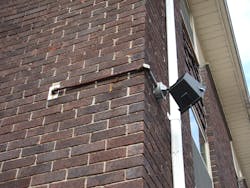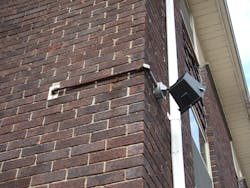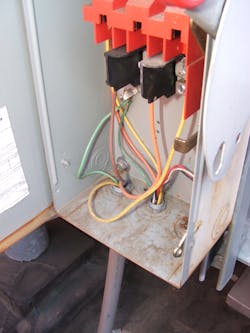All references are based on the 2023 edition of the NEC.
Access Denied
Gaining access to the wiring in the recessed box on the left side of this raceway run will be a real chore because a flexible raceway was not used. That rusted electrical metallic tubing (EMT) raceway will need to be disassembled to remove the cover. When I first spotted this installation, I thought the EMT was a liquid-tight flexible metal conduit (LFMC). Upon closer inspection, I realized it was EMT. Making surface extensions from a cover is permitted by the Code, but this installer did not do it correctly. Section 314.22 requires surface extensions to be made by securing an extension ring over the box, but the exception permits surface extensions to be made from the cover of a box — if the cover is unlikely to fall off or be removed assuming its means of securement becomes loose. It also requires flexible wiring methods to be used when making an extension from a cover. The length of the flexible wiring method must be such that it permits the removal of the cover and provides access to the interior of the box. Grounding and bonding continuity must be independent of the connection between the cover and the box.
Lord of the Knockout Rings
Stuffing several equipment grounding conductors (EGCs) into a lug designed for only one conductor is the first problem I want to point out here. Section 110.14(A) requires terminals for more than one conductor to be identified for that use. The next problem here is the lack of bonding bushings installed on the connectors for the metal raceways where they enter this metal enclosure. We don’t want fault current traveling through those knockout rings on circuits above 250V to ground. Where oversized concentric or eccentric knockouts are encountered when installing circuits of over 250V to ground, Sec. 250.97 requires electrical continuity between the metal raceway and metal enclosure to be ensured by bonding and grounding methods specified for services in Sec. 250.92(B)(2), (3) or (4). Bonding bushings with bonding jumpers should be used for bonding these raceways containing 480V circuit conductors. If no knockout rings were encountered — or if the enclosure was listed for reliable bonding above 250V to ground — then following the bonding techniques specified in Sec. 250.92(B) would not be required. In this case, typical threadless connectors could be used or cable connectors with one locknut inside the cabinet (as was done, albeit incorrectly here), or other listed fittings could be used.
About the Author

Russ LeBlanc
Owner
Russ started in the electrical trade as an apprentice in 1985. He worked his way up to become a Journeyman Electrician and then eventually became a Master Electrician and Licensed Construction Supervisor. In 1999 Russ become an Electrical Instructor for The Peterson School of Engineering in Massachusetts where he developed his passion for teaching, and quickly became Department Head of Electrical Instruction. Russ has taught thousands of apprentices, electricians, engineers, inspectors, and other electrical professionals during his career as an instructor. He continues to provide electrical professionals with Electrical Code seminars, Arc-Flash Awareness training seminars and educational material through his LeBlanc Consulting Services in North Reading, MA whose specialty is educating electricians. He has been an active member of the NFPA Electrical Section and has authored hundreds of National Electrical Code proposals and comments which have become Code rules to improve the safety for the electrical industry. Russ is also an IAEI certified Electrical Inspector.
Please visit www.russleblanc.net for more information.


